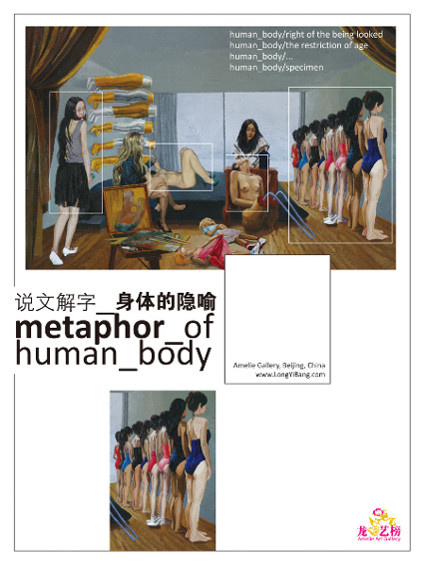Everyone bears his own thought, which he himself has to defend.
-Arnold Joseph Toynbee, British Historian.
Human body has been an eternal subject in art history. In the aesthetics of ancient Greek sculptures, human body is the perfect form of power and beauty which is used as an ideal model to build sculptures of Gods. While in traditional Chinese culture, the idea of unity of heaven and humanity has led to a lasting interest in the spiritual aspect of human body throughout the history of literati paintings. In modern time, with the born of pop art, human body has been a mirror reflecting social sub- cultures and transitional self-awareness. It has been connected to wider social phenomena such as fashion and celebrity (e.g. Andy Warhol), advertisement and consumerism (e.g. Jeff Koons), as well as gender and identity (e.g. Cindy Sherman) etc.
Recognizing the pluralism of today's art practice in China, this exhibition, with a focus on the theme of human body, would examine the individual characteristics shown by a group of Chinese young artists in making body-related arts of their own.
The curator invites the artists to fulfill the following two tasks.
Task One. Filling the blank with a metaphor on human body in artist's vision: Body/
Please fill in the blank area with a phrase or a sentence to express your conceptions of human body in your artistic practice, such as Body/ Symbol of perfection and power(for ancient Greek sculptures), Body/ Spirit or strength of character (for ancient Chinese literati paintings) etc. Then, please elaborate the phrase or sentence based on your cultural and personal experience.
Task Two. Analysis your exhibited work in details.
Please select one of your exhibited works (either a sculpture or painting) and apply visual analysis (on the gestures, clothing, actions, facial expression and composition, colors, brush works or formats) to explain what you want to express through such arrangements and presentations.
In portraitures from Ming dynasty, the famous hermit Tao Yuanming is often depicted with a background of pines and maples, sometimes accompanied by an ancient musical instrument and other properties. The artist uses the evergreen pine as a symbol of Tao Yuanming's unyielding literati personalities. While the maple implies how time flies. All the settings and properties in the background work together to unshed the hidden moralities, sharp insights and reclusive spirits of the protagonist.
For this exhibition, the curator intends to apply a similar research method of ancient Chinese paintings to contemporary art works. By following clues and traces remained on surface, it explores the hidden truth of sub-conscious, at the same time providing a guide for the viewers to further understand the art work.
Li Bo
Body/Outward connection and inward reflection
Analysis an exhibited work:
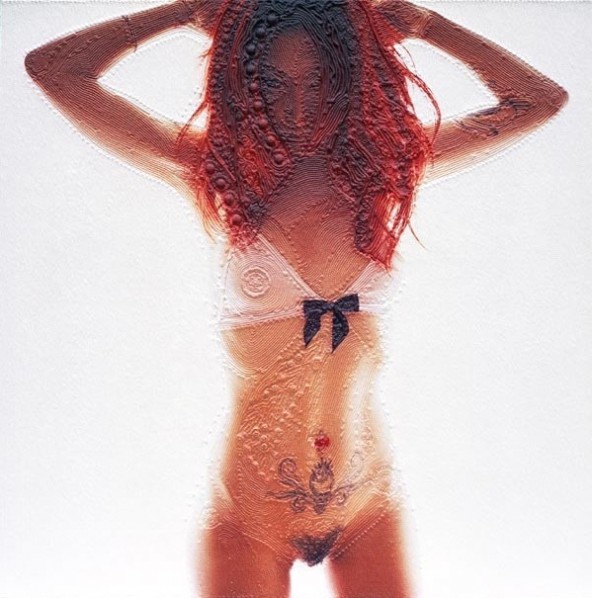
Black Bowknot, Cord-knitted, Hand painted with Special ink, 150x150cm
Language fails me when an elaborate explanation is needed, as the work has estranged from me since its birth. I believe that art is the most open form. People are all artists but not all of them make artworks. When facing the same piece of artwork, everybody has different feelings (sad or happy) arising from individual experience and different viewpoints of the world, but all of which are justified. In my case, I make sensatory inquiries which have no perfect linguistic interpretation. It happens that my answers always invite new inquiries which drive me to go on to destroy and reconstruct.
Zhang Qian
Body/Gaze from a dreamland
In real world, our bodies and minds are bound by too many laws of nature and moral standards, which would be thoroughly overthrown in the world of painting.
If the painting is a dream, then the painter is a dream maker, turning every canvas into a fantasy-like dreamland. On the luminous and lively stage, your imagination grows out of nothing and swells without limit. In the paintings, the body is a symbol of a dream maker, whose existence is free from the physical figure and become a common property which I have longed for. As the eyes in the images turn around to the viewers’, all thoughts carried by the image are delivered in a mere gaze.
Analysis an exhibited work:
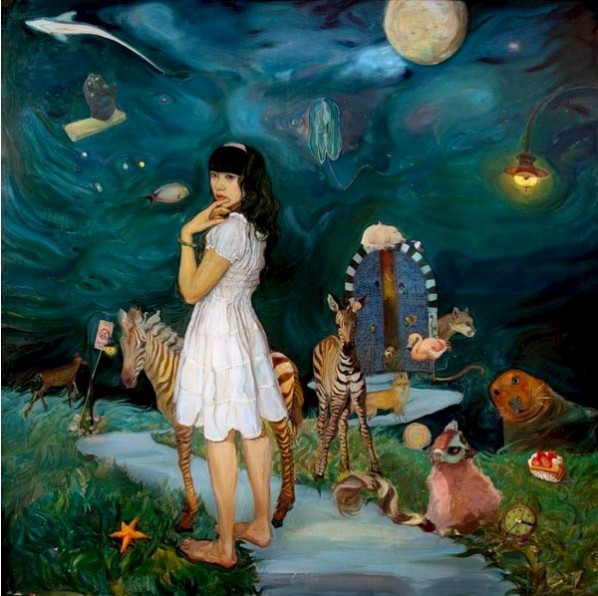
The Finest Voyage, 150x150cm, oil on canvas and mixed media installation
The Finest Voyage is a voyage of both body and mind deep into the ocean, a fascinated dreamland which makes the impossible possible.
The inspiration of the painting comes from my ages of confusion. With things unknown and temptations everywhere, the main figure stands on a road leading to an unlatched door. In many cases doors have symbolic meanings. Here it represents the watershed between the known and unknown. Once you step beyond, irreversible changes would take place. So before crossing the door, one would turn around and gaze back with thoughtful worries, just like any other moment of choice making. However the start and ending would be, life is a voyage deemed through countless unknown and known places. Is it beautiful? Maybe.
Yu Ying
Body/Right of the being looked, Specimen
At first, my works are about the narratives of the body as a specimen, i.e when the body is manipulated by extrinsic ideas or concepts, it no longer belongs to oneself. Usually I choose bodies with two characteristics, either the anatomical body or the performing body. As part of the image, different bodies are displayed side by side, producing multiple realities which are in conflict with each other. But if we take the image as a whole, such pieces of broken realities are therefore assembled, bringing complexity to the entire space by producing an ambiguous property between being normal and abnormal. I often choose partial depictions or close-up details from part of a photo and place them in the open space of my canvas, making them look like traces or broken pieces left in the air momentarily. The body is also a compositional element as equal as other elements that are not human body, such as sofa, raps, cloths and curtains.
Currently, the body is still presented in my paintings but for a different reason. I am more interested in the relationship between the body and the viewers, which is taken in art history as the right of the depicted, especially the right of the woman being depicted. I imitate the techniques and viewpoints of the Shanghai Realistic painters and the Northeast Realistic painters in China, treating the body as a fictional character instead of a visual object. In Painters from Shanghai and Painters from savage lands in the north, my inquiries have transferred into observations and reflections on styles and geographical cultures. By imitating their vision , I am examining the relationships between the given forms and myself, reflecting on my painting logic in making arts outside my own painting habits.
Analysis an exhibited work:
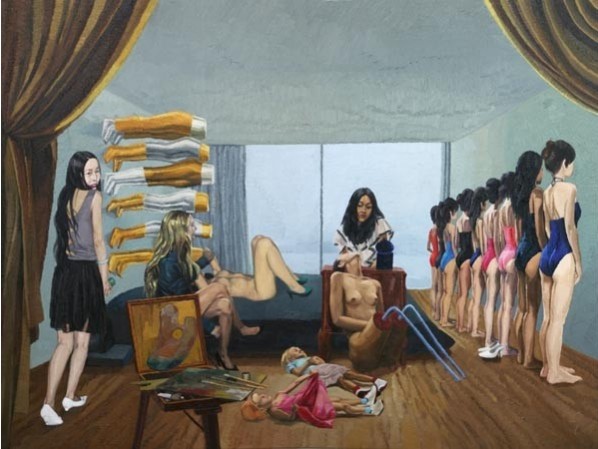
Yu Ying-Others’ Muses from ‘Painters from savage lands in the north’ series
Yu Ying-Others’ Muses from ‘Painters from savage lands in the north’ series
I was drawn to the term of Conceptual Painting in my university time because of some so-called conceptual painters such as Wang Xingwei, Qin Qi and Li Dafang, all of whom come from the northeast China. Then I was surprised by the interplay happens within the geographical area. According to my observation, they shared the technique to build shapes and volumes by piling up paints thickly with a preference in colors similar to the deep grey widely applied in academic paintings from the former Soviet Union. It remains as a geographical interest which is obvious even in the youngest generation of painters from the northeast China. It provokes me to think about the origin of geographical traditions, the birth of the established rules of making arts in the art system and the formation of inertia habits for individual artists.
The close-up view of this painting is made up of a painting box and a pile of tools, both implying the existence of a painter. The uneven ground is covered by the earth, with a texture similar to that of the paints, producing an ambiguous impression between outdoor and indoor space. Figures in the painting are adapted from real people,including a PR girl of an international art gallery, an actress in film Boogie Woogie, a lover repeatedly painted by an artist and a lead dancer selected by a dance academy for a live show. These females are often taken as the artists’ Muses. I dedicatedly choose other people's Muses to avoid the influence of my own preference of female in this painting.
Song Yi
Body/Spirits, feel the present
Analysis an exhibited work:
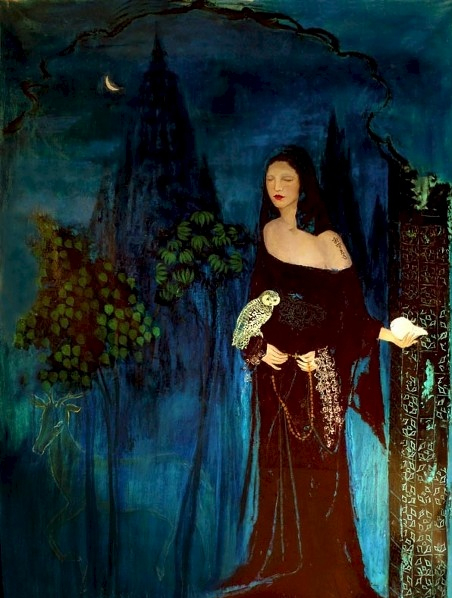
Song Yi-Shine upon the sleepless, 150x190cm, Oil on canvas, 2013
‘Shine upon the sleepless’ presents the moment when I depart under the moon and stars to Bodhgaya where the Buddha achieved enlightenment. The Buddhist pagoda stands with dignity, and up in the sky the moon shines, making the scene a mysterious mirage.
The image depicts the particular moment when my body and mind are being shone upon at the holy place. Emerged in a subtle blue atmosphere, the moonlight above the Mahabodhi Padoga is capable of illuminating a millenarian darkness with its sacred silver light. The protagonist stands with the pagoda in a robe, repressing a myriad of thoughts and ideas. She holds a white conch as the sacred instrument in her hand, overwhelmed in the long-lasting conch tunes. As the moonlight washes the dirt away from my body and mind, a lotus silently blooms in my softened heart. Every tree and grass here is witness of earnest prayers and sincere memories of pilgrims throughout the millennium. Thus the moonlight is clear. All lives filled with emotions are no longer humble. Who knows how many people are there that have sensed the limit of darkness at the particular moment, how all distracting thoughts and ideas become Buddha.
This moment, a shy child becomes an amiable Buddha.
About the exhibition
Duration: 2013.6.22-8.15
Venue: Amelie Gallery
Artists: Li Bo, Yu Ying, Song Yi, Wang Lin,Zhang Qian
Curator: Tony Chang
English Translation: Evonne Wang
Opening Reception: 2013.6.22 15:00pm
Courtesy of the artists and Amelie Art Gallery.


